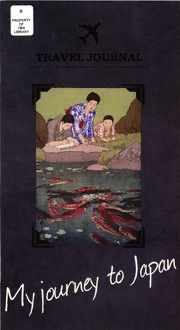
Travel Journal: My Journey to Japan PDF
Preview Travel Journal: My Journey to Japan
B PROPERTY OF TMA LIBRARY I r--l l,- tt 't e r,TT'J-T-I'T} A)o wWru This guide is intended. for children and their fanilies to use as they explore ?resh Impressions. The exhibition, primarly of woodblock prints from Japan, has a lot of interesting things to see- including an:ima1s, volcanos, actors dressed up in costumes Gome holding swords!), and women wearing beautiful dresses (called kimono). As you travel through the exhibition, we want you to J-ook closely at these works of art and imagine trip you are on a through Japan. tlho wiIL you naet? tlherre would you like to go? t{hat ritt you do? TfreB€dVtNlo@lTlRrulWtT[rf'tuseu|4(51o not your hands' and your eyes with . LooI< .\,{ail(s}ow}yinthegaueryandlook caBefully' from alray rength an arms stay ar'east it a}}' . can see You of aT:-so the work to write down not apen' use apellcil' . a drawing' or make ideas trrcorveur Carpr inr a rPonDd by ttirrosuhi Yoshida [Hee-roh-shee Yo-shee-dah), L926. ,rruuuurtrt / \ AtrORS Hht'tr,oN Nh ,H LAAMCATCS BCALffTFUL \ WOMEN N BINITFUL\^t0l',4e ROCK 6 weN BRDS A B€NITTFUL FPWEBS WOMCN €Allwc€ CAA|ADAY hAIIEW / \ MA?)FaH(BfAlV rrrrl / TFITCXT{(BruN Fresh rnpressions is an exhi.bition of works of art by Japanese woodblock print artists from the early 2oth century. The history of woodblock printing in Japan is both long and distinguished, dating as far back as the year 77O. Beginning in the 191os, Japanese artists revived this art form from its height in the I?oos and early 18OOs. In their woodblock prints they combined traditional Japanese techniques and subjects with inspiration from the art of Europe and America. nMCWORDSIO KNOW woodblock pr{:rti.ng: Printmaking technique of carving an image onto a block of wood, covering it with inh and pressing it onto paper. Kirnono [P*n*tArJ, A 1oose, wide-sleeved. Japanese robe, commonly worn by women and often elaborately decorated; held together at the waist with a broad sash called an obi. fauarrrrrr [t*wAr} Kabuki A type of popular Japanese stage drama in which elaborately costumed performers use stylized movements, dances, and songs to enact tragedies and comedies. only men are Kabuki actors, performing even the female roles. Knnadori [t*r*Wo} Stage make-up worn by Kabuki actors, specifically bold stripes of color on a white background. The colors and designs often have symbolic meaning relating to the character that wears it. pat*!,} shin haasa Term meaning "new prints;" this is what artists in the early l9OOs ca11ed their revival of Japanese print woodblock techniques and subjects from the 1700s and early 1800s. uie [na-ehJ, In Kabuki Theater, a dramatic pose that the actor holds-almost like a close-up in a movie-to express a significant emotional moment in the pIay. fsTt14e10w Nnw yottL)ou4Nillowl rr frr TUfUrUUrrr- B (N Lt^/Ol4eN Be Lc0rues As you enter the exhibition, can you find any prints of Japanese women in a kimond Originally, "kimono" was the Japanese word for clothing. rn more recent years, the word has been used to refer specifically to traditional Japanese robes. Kimono are often made from silk with elaborate patterns and decoration. * \A L tr G { I -, 'lf 0. aI 6t , ri .1tila, $t <l r (. (-i t*?+ Before the Mirror by ffiE Natori Shunsen INah-tor-ee Shun-sennl, L928. ffrrrDlrrr 7J JT'J TTUT Look at the images and find a woman wearing a kimono who looks like someone you'd like to talk to. rf you could ask her what she is doing, what do you think she would teI1 you? Describe the pattern on the kimono she is wearing. Does the pattern remind you of anything from nature? Trne T0 DooDtE! Draw the klmono's pattern, or design one of your own, in the space provided. I rfr fr u-t u, --t -] BR6 k F\OW,RS The green head and ye11ow bill of the mallard duck is a famil-iar sight to the ,lapanese, iust like it is for us in the United States. Mallards like caIm, sha1low sanctuaries, but can be found in almost any body of fresh water. Find an image of birds that you particularly like How many birds are in the print? Are they in the air, on water, in a tree, or somewhere else? What does it look J-ike they are doing? ^l & s * e 4 / ,I I Ducks by Hashiguchi Goyo [Uah-shee-goo-chee Goy-yoh], 192J- If you could hear this bird, what would it sound like? frrurrrrru k LAlt6G4TeS FAI4O US TLAGS Between the Japan Alps and Tokyo lies Mt. Fuji Gujiyamd, the most famous mountain in Japan. It has a beautiful, conical peak that is the country's tallest mountain (12,390 feet). In the summer many people climb to the top of Mt. r'uji. Even in JuJ-y and August, temperatures at the mountaintop reach only around 41 to 43 degrees Fahrenheit. Search for pictures of landscapes in the exhibition. Choose one that shows a place you would J.ike to visit on your trip. E L raiiyana from okitsu by Hiroshi Yoshida [tiee-roh-shee Yo-shee-dah], l928 TMrlO (MM ( US€ YOUR. What would you need to pack for your visit? What do you think the weather will be like? Who do you think you might meet? f ,,,,,,,,, / J J J J JT JJJl WUK( ACNRS Along with costumes, sollgs, and dances, Kabukl [kah- boo-keel actors use exaggerated poses ca1led nie(mee- eh) to express strong emotions. These poses are often accentuated by highly energetic facial expressions and flamboyant makeup (kunadori [koo-mah-door-ee]) that bring out the character's personality and mood. *+ I' tlrr a t 2 t o a B: Kataoka fchizo fV as Benkei by lY,atori Shunsen [Nah-tor-ee Shun-sennl , l92B gl4e TMe l0 D0 A(TrN6t See if you can make your face look like the actors. Can you pose like the actor? fls1y does it make you feeJ- to act J.ike this? Try to find an actor whose facial expression is very different from the one you chose. Trrr !r
